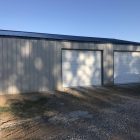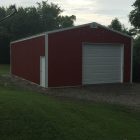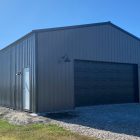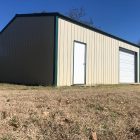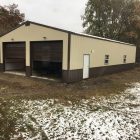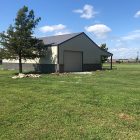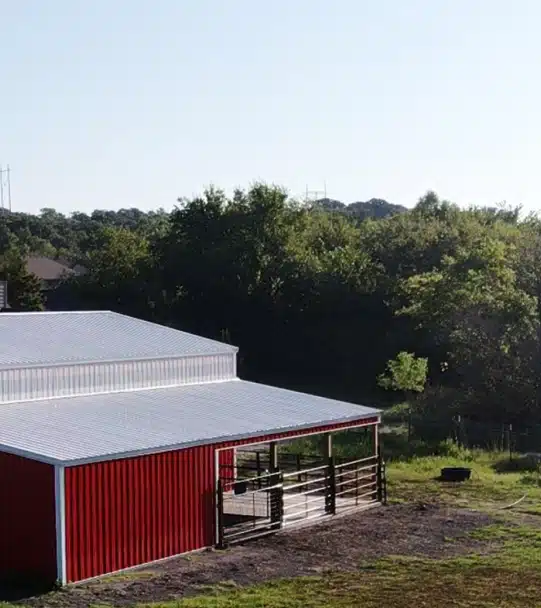Pole barns and traditional buildings are two popular options for constructing a new building. While both can serve similar purposes, there are significant differences between the two types of construction that should be considered before making a decision.
In this blog post, we will explore the main differences between pole barns and traditional buildings, as well as the advantages and disadvantages of each. We will also discuss why choosing the right type of construction is essential and highlight your trusted source for quality pole barns and traditional buildings in Oklahoma – Meadows Buildings.
What is a Pole Barn?
A pole barn, also known as a post-frame building, is a simple structure made of wooden posts or poles embedded into the ground to support the roof. The walls are typically made of metal siding, while the roof can be constructed with metal, shingles, or other materials.
Pole barns are relatively easy and quick to build, making them a popular choice for agricultural purposes. They also have a clear-span design, meaning there are no interior columns obstructing the space inside.
Some common uses for pole barns include:
- Storing farm equipment or machinery
- Housing livestock such as horses or cattle
- Providing a workspace for woodworking or other crafts
What is a Traditional Building?
On the other hand, traditional buildings are constructed using more conventional methods, typically with wooden framing and bricks or concrete for the walls. These buildings often have a sturdier structure and can withstand stronger winds and heavier snow loads compared to pole barns.
Traditional buildings also offer more design options and can be customized to fit your specific needs. They also tend to have better insulation, making them more suitable for year-round use.
Some common uses for traditional buildings include:
- Residential homes
- Commercial buildings
- Storage facilities
Main Differences between Pole Barns and Traditional Buildings
Materials Used
One of the main differences between pole barns and traditional buildings is the materials used in their construction. Traditional buildings typically use heavy-duty materials such as wood, steel, or brick for their walls, while pole barns are primarily made of wooden posts and trusses with metal sheeting for the walls and roof.
The use of wooden posts in pole barns allows for a more cost-effective construction process, as well as easier customization. On the other hand, traditional buildings tend to be more durable and can withstand harsh weather conditions better than pole barns.
Building Process
Another critical factor to consider is the building process itself. Traditional buildings require a more complex and time-consuming construction process involving foundations, framing, roofing, and finishing work. This can result in higher labor costs and longer construction times.
Pole barns, on the other hand, have a simpler building process as they do not require a foundation and can be built directly on the ground. This means less time and labor are needed for construction, making them a more cost-effective option.
Purpose and Functionality
The purpose and functionality of the building also play a significant role in choosing between pole barns and traditional buildings. Traditional buildings, such as homes, offices, or retail spaces, are often used for residential or commercial purposes, where durability and aesthetics are essential.
Pole barns, on the other hand, are primarily used for agricultural or storage purposes. They can provide ample space for storing farm equipment, livestock, hay, and other materials. Additionally, pole barns can also be used as workshops or garages due to their open layouts.
Customization Options
One of the significant advantages of traditional buildings is the ability to customize them according to specific needs and preferences. With a variety of materials and design options available, traditional buildings can be tailored to suit various styles and purposes.
Pole barns, on the other hand, are more limited in terms of customization. However, they still offer some flexibility when it comes to size and layout. Additionally, pole barns can be easily expanded or modified in the future if needed.
Cost Comparison
Cost is often a major factor when considering different building options. Traditional buildings tend to have higher upfront costs due to the materials and labor involved in their construction. However, they can also potentially increase property value over time.
Pole barns, on the other hand, are generally more affordable and offer a budget-friendly option for those needing a large storage or agricultural space. While they may not add significant value to a property, they are still a practical and cost-effective choice for many.
Advantages and Disadvantages
Pole Barns:
Advantages:
- Cost-effective
- Quick and easy construction
- Durable with proper maintenance
Disadvantages:
- Limited design options
- Not suitable for specific purposes, such as living spaces.
Traditional Buildings:
Advantages:
- Versatility in design and functionality
- Can improve property value
Disadvantages:
- More expensive than pole barns
- Longer construction time
Why Choosing the Right Type of Construction is Important
Choosing the right type of construction for your building project is crucial, as it can significantly impact the functionality and longevity of your building. Pole barns may be a more cost-effective option, but they may not be suitable for all purposes. Traditional buildings offer more design options but may come at a higher cost.
Meadows Buildings – Your Trusted Source for Pole Barns in Oklahoma
When it comes to quality pole barns and traditional buildings, Meadows Buildings is a name you can trust. With over 15 years of experience in the construction industry, we specialize in providing custom-built pole barns that meet our customers’ specific needs. Our team of experts uses high-quality materials and follows strict building codes to ensure the durability and safety of our buildings.
In addition to pole barns, we also offer traditional building options for residential, commercial, and agricultural use. Our experienced team can help you design and construct the perfect building for your needs.
Conclusion
Understanding the differences between pole barns and traditional buildings is crucial when deciding which type of construction is best for your project. Factors such as construction process, cost, and functionality should be taken into consideration before making a decision. At Meadows Buildings in Oklahoma, we offer top-quality pole barns to cater to all your construction needs. Contact us today at (918) 615-2251 for more information or to get started on your custom building project!


